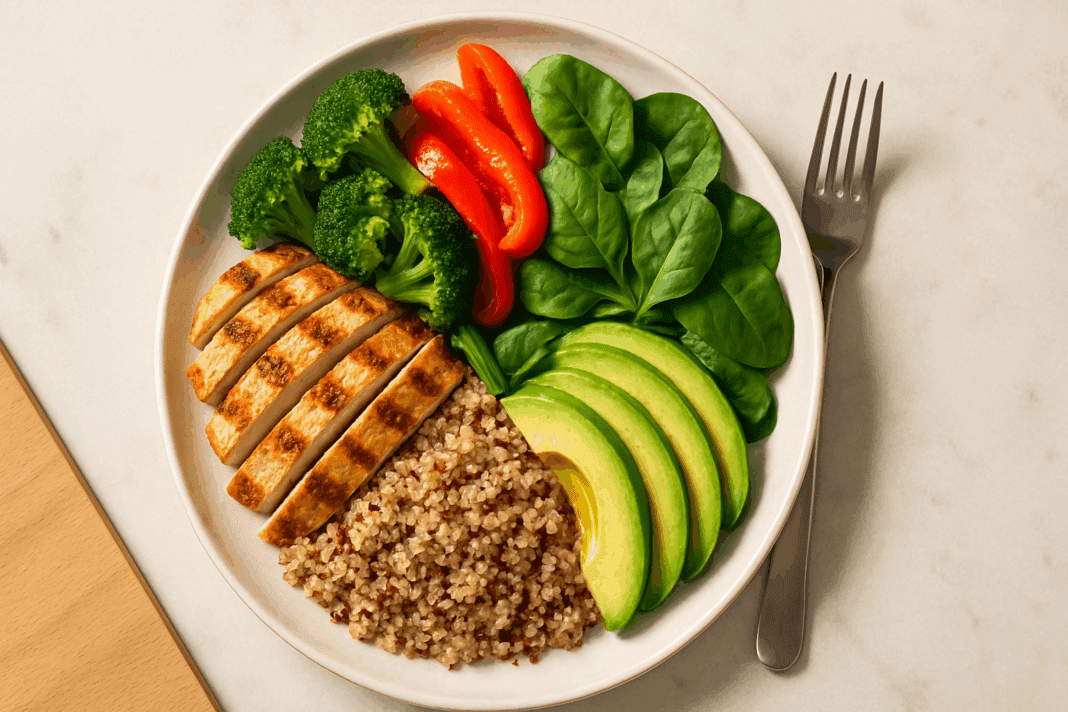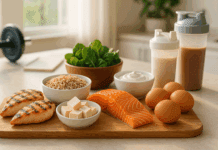In the age of hyper-processed foods and sedentary lifestyles, optimizing our nutrition is no longer just a wellness trend—it’s a necessity. A balanced plate offers more than visual appeal; it is a tangible framework for achieving long-term health, vitality, and metabolic stability. For those pursuing a cleaner, higher-performing lifestyle, high-protein diets have emerged as a cornerstone of modern nutrition. When strategically integrated into a balanced plate, protein can serve not just as a muscle-builder but as a key player in hormone regulation, satiety, immune support, and overall metabolic efficiency.
You may also like : The Ultimate Guide to Choosing a High Protein Diet Name That Fits Your Goals
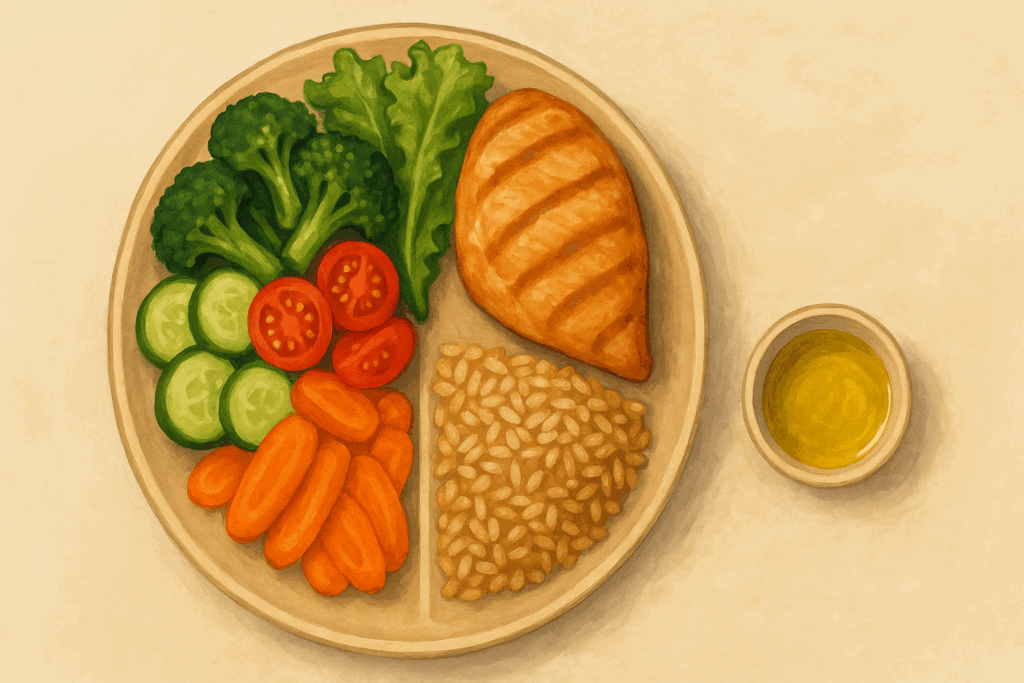
Understanding the Power of a Balanced Plate
The concept of a balanced plate serves as a visually intuitive and nutritionally grounded model for portion control and nutrient diversity. A true balanced plate includes an ideal proportion of macronutrients—proteins, carbohydrates, and fats—alongside essential micronutrients like vitamins and minerals. This structure not only sustains energy throughout the day but also enhances digestion, absorption, and cellular function. While many health trends advocate for extremes, such as carb elimination or fat restriction, the balanced meal plate emphasizes harmony. It aligns with physiological needs, offering the flexibility to adapt to individual goals like muscle gain, weight loss, or energy enhancement.
Historically, dietary guidelines have focused on calorie counts and food group distribution. However, such static models fail to capture the dynamic interplay between nutrients and lifestyle. A balanced plate recognizes this complexity and provides a more functional roadmap to health. When personalized, this model becomes an adaptive tool that reflects cultural preferences, culinary traditions, and activity levels. As part of a broader healthy eating meal plan, it becomes the anchor for consistent dietary success. The question many ask is, “What does a healthy diet look like?” The answer often lies not in extremes, but in a plate intentionally composed to support optimal performance and resilience.
Why High-Protein Diets Deserve the Spotlight
Proteins are not merely structural components of muscle tissue; they are dynamic agents of physiological transformation. Amino acids, the building blocks of proteins, play critical roles in enzyme function, neurotransmitter synthesis, and tissue repair. A clean eating diet plan that emphasizes high-quality protein sources can improve metabolic health by stabilizing blood sugar levels, enhancing satiety, and reducing cravings.
High-protein diets also support lean muscle preservation during caloric deficits, which is essential for sustainable fat loss. Unlike many low-calorie meal plans that trigger muscle catabolism, protein-centered approaches ensure that the body preferentially burns fat rather than muscle tissue. For athletes and fitness enthusiasts, this translates into improved recovery and performance. For sedentary individuals, it means better metabolic resilience and reduced risk of sarcopenia.
Another underrated benefit of high-protein diets is their thermogenic effect. Digesting protein requires more energy than carbohydrates or fats, leading to a slight but meaningful increase in calorie burn. When paired with a healthy diet meal plan, this thermic advantage can accumulate over time to support gradual, consistent weight management. Furthermore, proteins have a hormonal impact—regulating ghrelin (the hunger hormone) and increasing peptide YY, which promotes feelings of fullness. These effects are foundational to understanding what is a good diet that truly supports long-term health.

What Foods Are Considered High-Protein Staples?
Navigating the grocery aisle in search of protein-rich ingredients can be overwhelming. But knowing what foods is protein-dense allows consumers to make intentional choices. Lean meats such as chicken breast, turkey, and grass-fed beef offer high biological value and essential amino acids. For pescatarians, fish like salmon, sardines, and tuna are not only protein-packed but rich in omega-3 fatty acids, which support brain and cardiovascular health.
Plant-based eaters are not left behind in the quest for protein. Legumes like lentils, chickpeas, and black beans provide both protein and fiber, supporting gut health and cholesterol management. Soy-based products such as tofu, tempeh, and edamame are complete proteins, making them particularly valuable in vegan diets. Nuts and seeds—especially almonds, chia seeds, and pumpkin seeds—deliver not only protein but healthy fats and vital micronutrients like magnesium and zinc.
Dairy and egg options like Greek yogurt, cottage cheese, and eggs are versatile, nutrient-dense, and highly bioavailable sources of protein. These are especially useful in meal prep for a balanced meal plate. A smart strategy is to combine diverse protein sources across meals, thus enriching the amino acid profile and supporting comprehensive health. When asking “how can I eat healthy?”, the answer often starts with selecting high-quality proteins that support both macro and micronutrient needs.
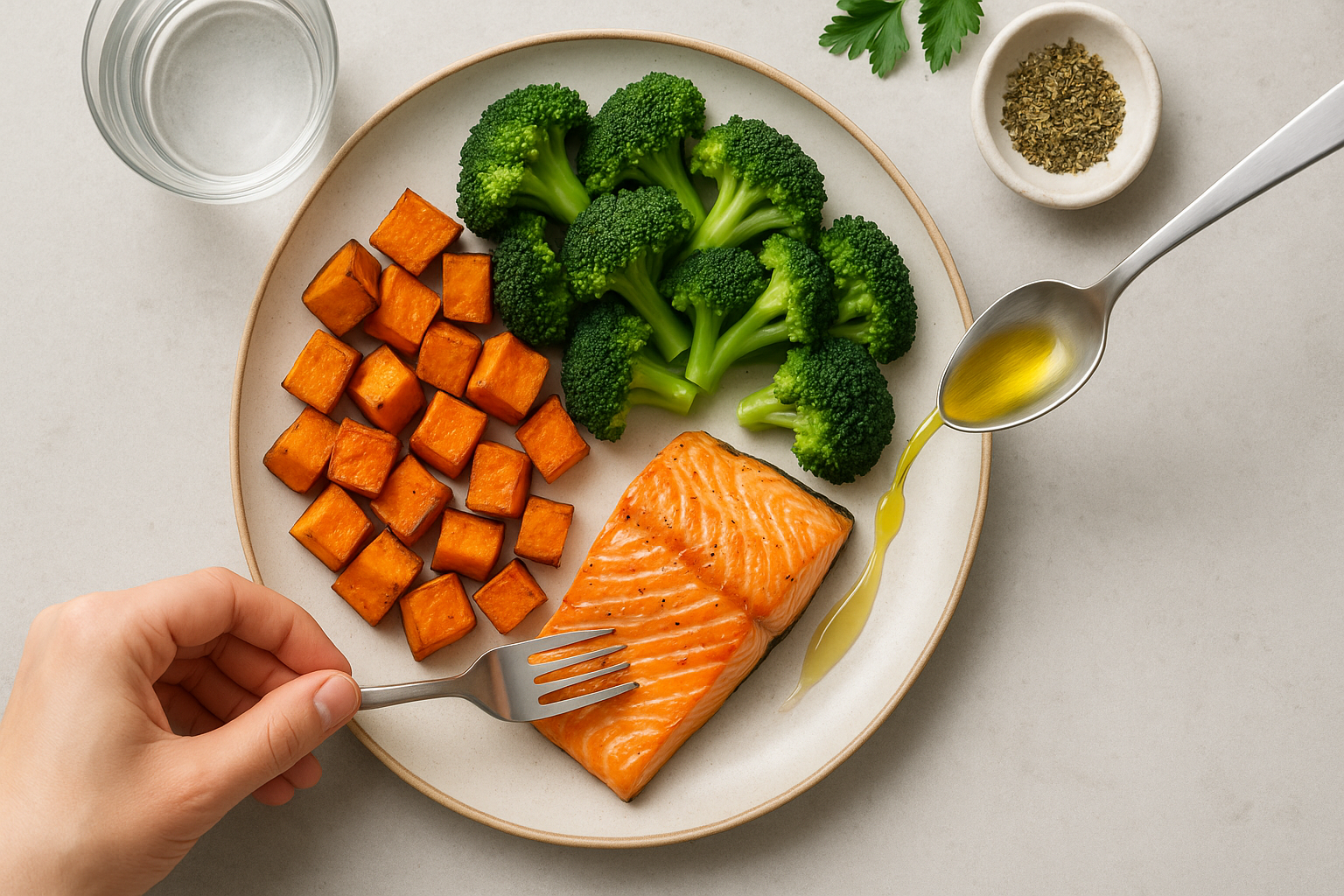
Designing a Balanced Plate Around Protein
Creating a high-protein, balanced plate begins with selecting the protein anchor. This could be a serving of grilled chicken, baked tofu, or poached salmon. The protein source should ideally take up about one-quarter of the plate. The next step involves adding complex carbohydrates such as quinoa, sweet potatoes, or brown rice. These not only provide sustained energy but also enhance the absorption of certain nutrients.
Vegetables should occupy at least half of the plate, offering a wide array of phytonutrients, fiber, and antioxidants. Leafy greens, cruciferous vegetables like broccoli and Brussels sprouts, and colorful bell peppers all contribute to cellular defense and digestive efficiency. Including a small serving of healthy fats, such as avocado slices or olive oil drizzled on salad, rounds out the macronutrient profile and enhances the bioavailability of fat-soluble vitamins.
For those seeking variety and efficiency, meal prepping high-protein meals in advance can be transformative. Batch-cooked proteins paired with a rotating selection of vegetables and grains create a modular framework for a healthy meal plan. This not only supports consistency but minimizes decision fatigue. It also encourages culinary exploration, answering the perennial question of “how to start a healthy diet” with practical, actionable steps.
The Role of Protein in a Clean Eating Diet Plan
The clean eating diet emphasizes whole, minimally processed foods free from additives, preservatives, and artificial ingredients. Within this framework, protein serves as both a functional and flavorful cornerstone. Clean protein sources include organic poultry, wild-caught fish, grass-fed meats, and non-GMO plant-based options. These choices align with the ethos of clean eating by minimizing environmental toxins and maximizing nutrient density.
Protein-rich clean foods are inherently satiating, which reduces the temptation to snack on processed, calorie-dense alternatives. A meal featuring grilled salmon, roasted vegetables, and quinoa not only fulfills macronutrient needs but also aligns with a sustainable and ethical food philosophy. Clean eating promotes mindful consumption, encouraging individuals to consider the source, preparation, and nutritional integrity of their meals.
A well-structured clean eating diet plan incorporates a rotation of protein sources to avoid nutrient gaps and maintain palate interest. Including fermented foods like tempeh or yogurt adds a probiotic dimension that supports gut health—a central pillar in overall wellness. When people ask, “how do I start eating healthy?”, clean eating with a high-protein focus offers a grounded and evidence-based approach. It also addresses the common concern of “what foods is actually good for me?” by steering individuals toward nutrient-dense, unprocessed choices.
What Does a Balanced Diet Look Like with High Protein?
A balanced diet incorporating high protein is not just about macros; it reflects an alignment of nutrient timing, food quality, and personal goals. The typical Western diet often overemphasizes refined carbohydrates while marginalizing protein intake. A corrected model integrates protein more evenly across all meals, rather than concentrating it solely at dinner. This practice improves amino acid availability, muscle protein synthesis, and satiety throughout the day.
Breakfast, often neglected or sugar-laden, becomes a nutritional opportunity when centered around protein. Greek yogurt with berries, scrambled eggs with vegetables, or a smoothie with protein powder, spinach, and almond butter all qualify as high-protein options that support metabolic steadiness. Lunches can feature lean meats or legumes atop fiber-rich salads, while dinners benefit from balanced combinations like grilled fish with roasted root vegetables and wild rice.
Snacking, too, is reimagined in this model. Hard-boiled eggs, hummus with veggie sticks, or protein bars with clean labels become nutrient-rich bridges between meals. This style of eating aligns with what a healthy, functional diet looks like—dynamic, satisfying, and performance-oriented. It directly addresses the common queries such as “how can I start a healthy diet?” and “what is normal diet behavior for optimal wellness?”
How to Eat More Protein Without Overeating
One of the challenges in transitioning to a high-protein, healthy eating meal plan is avoiding caloric overconsumption. While protein is satiating, calorie-dense options like fatty cuts of meat, excessive cheese, or processed protein bars can sabotage goals if not moderated. To optimize intake, individuals should focus on portion control and nutrient density.
Incorporating lean proteins in smaller, more frequent meals helps manage hunger and supports metabolic balance. Portioning out servings using visual cues—like a palm-sized piece of chicken or a cupped-hand portion of legumes—can prevent overeating. Selecting cooking methods like baking, grilling, or steaming further reduces unnecessary caloric load compared to frying or sautéing in excess oil.
Meal composition also plays a role. Pairing protein with fiber-rich vegetables and moderate healthy fats ensures balanced blood sugar response and prolonged satiety. This strategy makes it easier to follow a healthy meal plan without feeling deprived or constrained. Understanding “how to eat more healthy” often comes down to these micro-decisions around preparation, portioning, and pairing of foods.
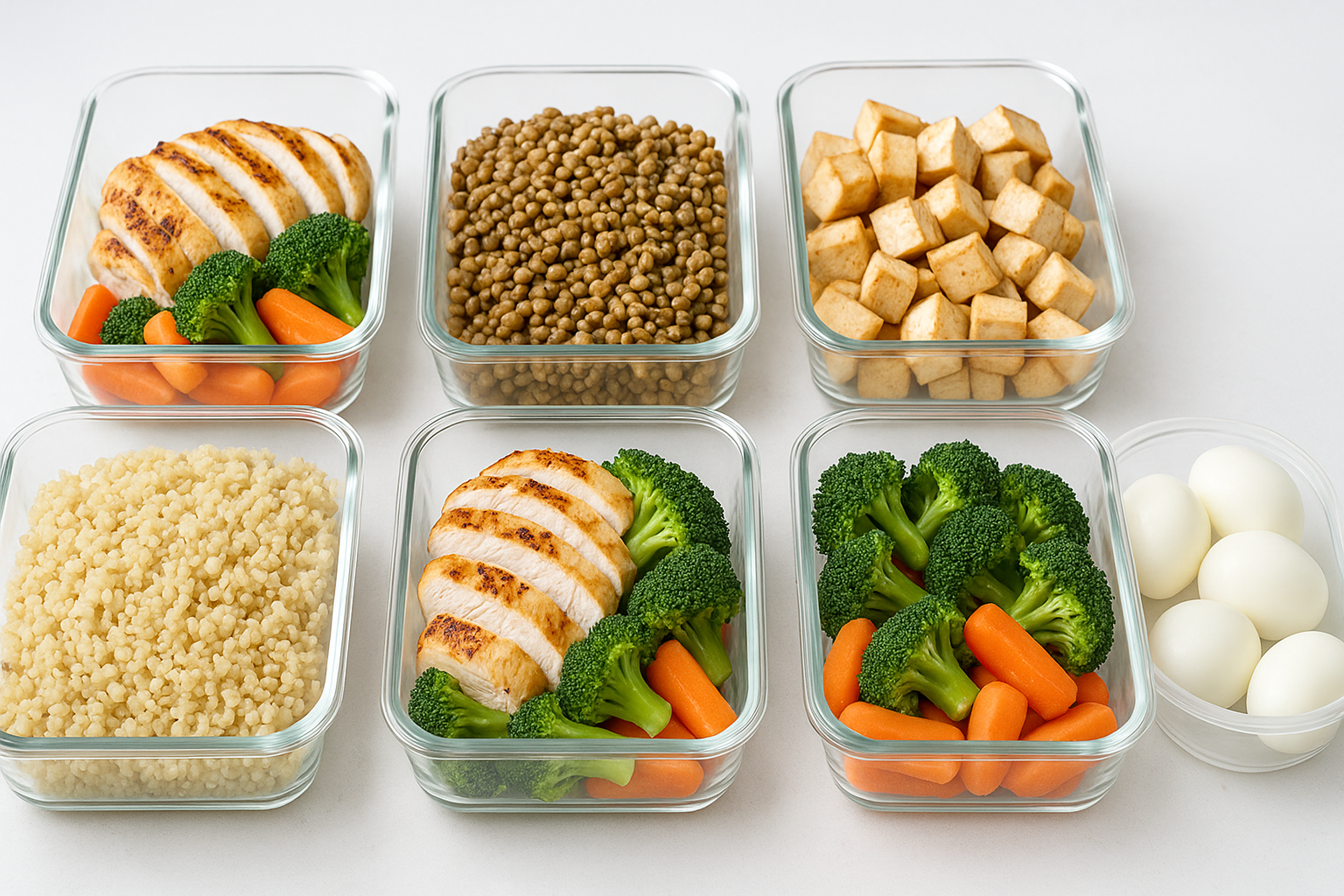
Suggestions for Eating Healthy While Prioritizing Protein
Incorporating high-protein foods into daily life does not require a complete dietary overhaul. Small, intentional adjustments can yield significant results. For instance, swapping sugary cereals for eggs or Greek yogurt at breakfast introduces a protein-rich foundation that stabilizes energy. Choosing quinoa or lentils over white rice during lunch elevates both protein and fiber content.
Meal prepping remains one of the most effective tools for ensuring compliance with a healthy eating meal plan. By preparing batches of grilled chicken, hard-boiled eggs, or marinated tofu, individuals create a ready arsenal of protein options to deploy throughout the week. This approach minimizes reliance on convenience foods and aligns with the clean eating diet ethos.
Hydration and timing also influence protein metabolism. Drinking adequate water supports kidney function, which is crucial when protein intake is high. Spacing protein evenly across meals enhances utilization and prevents the digestive discomfort often associated with large, infrequent portions. Ultimately, suggestions for eating healthy while emphasizing protein involve both macro-level planning and micro-level execution.

The Intersection of High-Protein Diets and Long-Term Health
Protein is not merely a short-term dietary lever for weight loss or muscle gain. It plays a central role in long-term health outcomes, including bone density, immune resilience, and cognitive function. Studies show that higher protein intake in older adults correlates with reduced risk of frailty, improved mobility, and better recovery from illness. Thus, high-protein diets are not just for bodybuilders but for anyone aiming to age with strength and vitality.
Moreover, high-protein diets support glucose regulation, making them beneficial for individuals with prediabetes or metabolic syndrome. When consumed as part of a balanced plate, protein slows the absorption of glucose, thereby reducing blood sugar spikes. This contributes to hormonal balance and energy consistency—key aspects of what a healthy, functional lifestyle entails.
Incorporating a diversity of protein sources also supports a healthy gut microbiome, especially when paired with fiber-rich foods. Fermented dairy, legumes, and certain meats contain compounds that nourish beneficial gut bacteria. This synergy between protein and gut health reinforces the multidimensional benefits of a high-protein balanced diet and dispels the myth that protein-focused eating is one-dimensional or restrictive.
What Are Some Healthy Foods That Complement High-Protein Meals?
A truly balanced plate doesn’t just emphasize protein; it incorporates complementary foods that amplify nutritional benefits. Leafy greens like kale, spinach, and arugula offer chlorophyll, iron, and antioxidants that support cellular detoxification. Root vegetables such as carrots, beets, and sweet potatoes provide slow-digesting carbohydrates and essential beta-carotenes that support vision and immune health.
Whole grains like quinoa, farro, and oats supply B-vitamins, fiber, and sustained energy. These grains work synergistically with protein to create a satiating, nutrient-rich meal. Berries, citrus fruits, and cruciferous vegetables add anti-inflammatory compounds that reduce oxidative stress—an important factor in athletic recovery and disease prevention.
Healthy fats from sources like olive oil, nuts, and avocados enhance the absorption of fat-soluble vitamins such as A, D, E, and K. These micronutrients are essential for hormone production, immune regulation, and cellular integrity. Together, these elements transform high-protein meals into holistic experiences that support every layer of wellness.
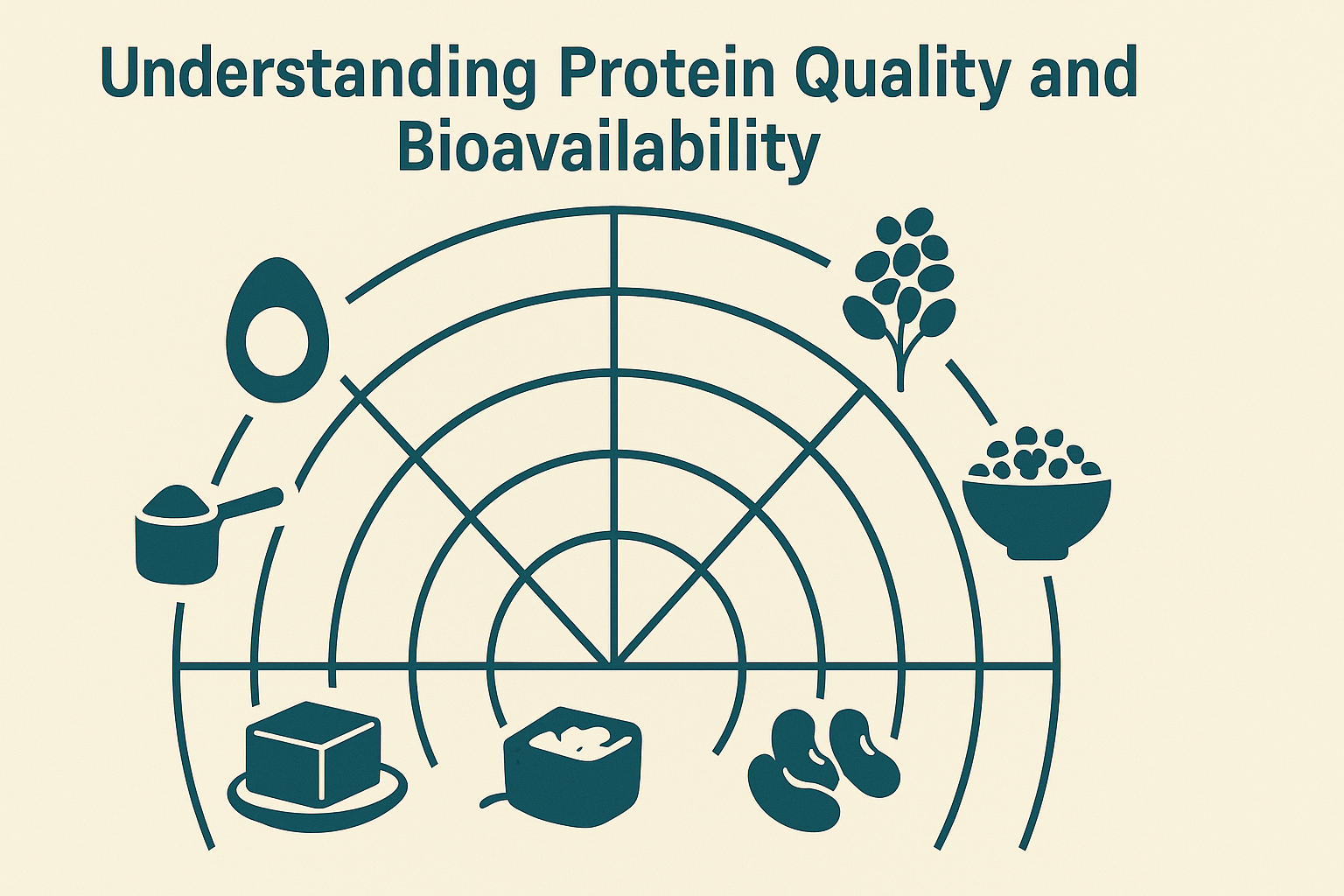
Understanding Protein Quality and Bioavailability
One of the most overlooked aspects of protein consumption is the quality and bioavailability of different protein sources. Not all proteins are created equal. The biological value (BV), net protein utilization (NPU), and protein digestibility-corrected amino acid score (PDCAAS) are scientific methods used to evaluate protein effectiveness. Animal-based proteins such as eggs and whey score highest on these measures, as they contain all nine essential amino acids in optimal ratios.
For plant-based eaters, combining different protein sources can enhance overall amino acid completeness. For instance, pairing rice with beans or hummus with whole wheat bread can create a complete protein profile. Understanding these combinations is crucial for anyone pursuing a vegetarian or vegan lifestyle while adhering to a balanced plate model. These synergistic pairings help support muscle repair, immune function, and hormonal regulation, reinforcing what a healthy diet should achieve on a physiological level.
Timing Matters: Protein Distribution Throughout the Day
Many individuals unknowingly skew their protein intake toward dinner, neglecting protein-rich breakfasts and lunches. This uneven distribution can reduce the efficiency of muscle protein synthesis and impact satiety patterns throughout the day. Studies show that consuming 20–30 grams of high-quality protein per meal enhances muscle recovery and metabolic balance.
To better align with what is proper diet practice, consider starting the day with a protein-rich meal such as an omelet with vegetables, a tofu scramble, or a protein smoothie. Lunch can include lentil soup, grilled chicken wraps, or quinoa salads topped with edamame. Spacing protein evenly across meals and snacks promotes a more sustained amino acid supply, helping to build lean muscle and control appetite—especially relevant when designing a healthy diet meal plan for weight management or active lifestyles.
Prebiotics and Gut Health in Protein-Rich Diets
High-protein diets, particularly those emphasizing animal-based proteins, can sometimes challenge digestive health if fiber intake is not balanced appropriately. Prebiotics such as inulin, pectin, and resistant starch play a role in feeding beneficial gut bacteria, enhancing nutrient absorption, and supporting digestive comfort.
Integrating foods like garlic, onions, bananas, and oats into a high-protein diet ensures that the gut microbiome remains diverse and resilient. This creates a symbiotic environment where both proteins and other nutrients are digested and absorbed efficiently. For those asking “what are some healthy foods that help digestion with protein?”, the answer often lies in pairing high-protein meals with fiber-rich, prebiotic vegetables and grains.
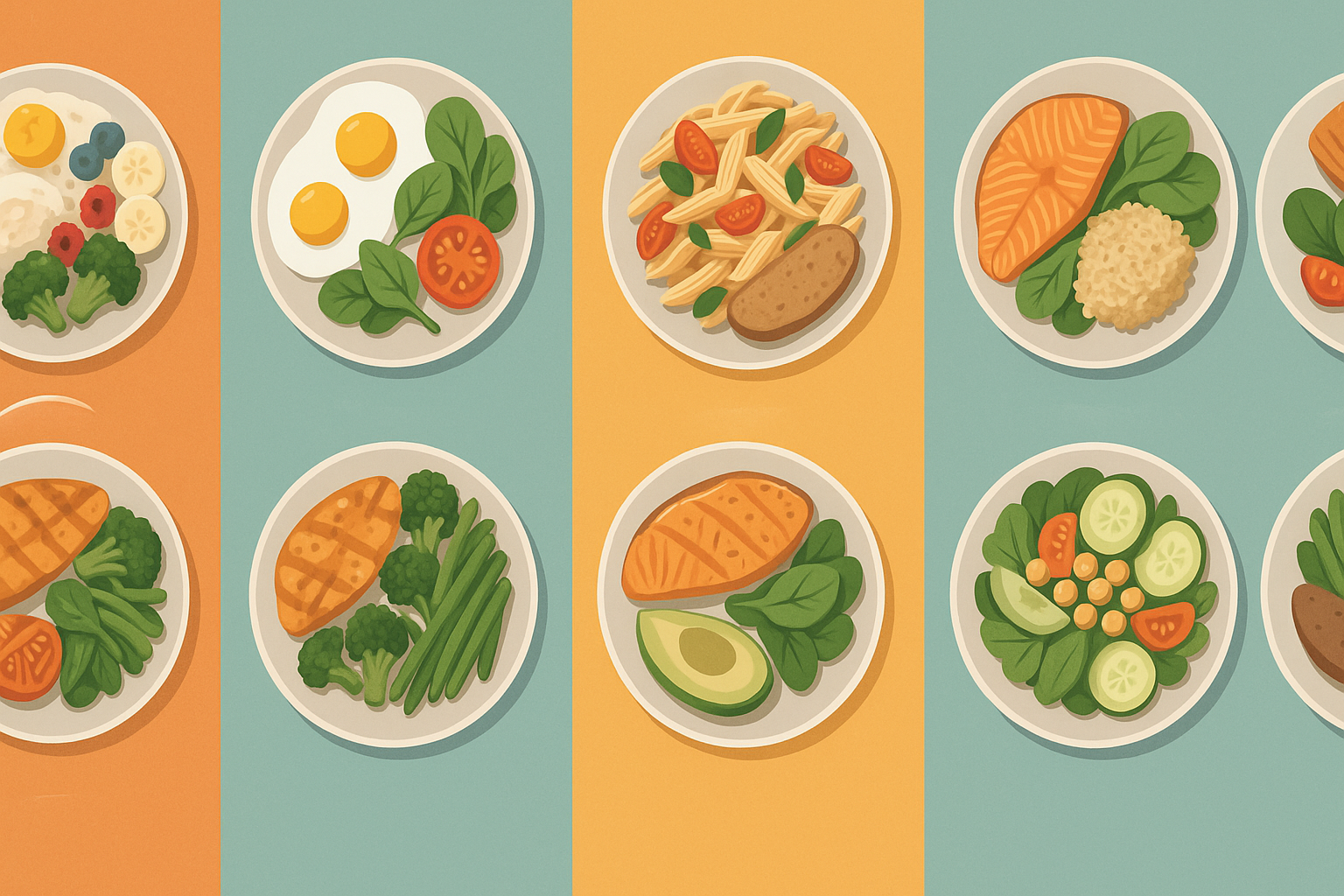
Protein Cycling: A Strategic Approach for Longevity
An emerging concept in nutritional science is protein cycling—the practice of alternating high and moderate protein days to stimulate different metabolic pathways. This method mimics ancestral eating patterns and has been associated with improved metabolic flexibility, insulin sensitivity, and autophagy (cellular repair mechanisms).
For example, consuming 1.6 grams of protein per kilogram of body weight on training days and dropping to 0.8 grams on rest days may optimize long-term health while preserving lean mass. This approach can be especially beneficial for aging adults seeking to maintain vitality without overloading the kidneys or stressing metabolic pathways. It also redefines what is a good diet by incorporating rhythm and balance, rather than static intake.
Leveraging Protein to Improve Sleep and Recovery
While commonly associated with physical performance, protein also plays a subtle but powerful role in sleep regulation. Amino acids like tryptophan are precursors to serotonin and melatonin—neurotransmitters involved in mood and circadian rhythm.
Consuming a small, protein-rich snack in the evening (such as cottage cheese, turkey slices, or a boiled egg) can improve sleep quality, especially when paired with a complex carbohydrate like whole-grain toast or banana. This nighttime synergy supports not only recovery but hormonal balance, creating a new perspective on what does a healthy diet look like—one that serves both day and night physiology.
What Is Proper Diet Planning in the Context of a High-Protein Lifestyle?
Proper diet planning begins with clarity of goals, whether that be muscle gain, weight loss, cognitive enhancement, or general health. From there, nutritional choices are reverse-engineered to match these objectives. For those pursuing muscle development, protein intake may need to exceed 1.6 grams per kilogram of body weight per day. For individuals focused on longevity and metabolic health, a more moderate approach that emphasizes diversity and micronutrient density may be appropriate.
Meal frequency, timing, and portioning are the scaffolding of a proper diet plan. Integrating snacks that reinforce protein intake and meal diversity supports adherence and reduces burnout. Rotating food sources also prevents nutrient gaps and sustains long-term interest. Importantly, a proper diet plan is adaptable—responsive to changes in lifestyle, activity, and health status.
This strategic mindset redefines “what is normal diet behavior.” It shifts the focus from rigidity to responsiveness, from calorie counting to nutrient orchestration. Proper diet planning thus evolves into a practice of precision and personalization, anchored in the principles of a balanced plate and informed by the science of high-protein nutrition.
Frequently Asked Questions: Mastering High-Protein Nutrition with a Balanced Plate
1. What are some lesser-known plant-based protein sources I can add to my meals?
Beyond tofu and lentils, there are many underutilized plant-based proteins that can diversify a clean eating diet plan. Hemp seeds offer a complete amino acid profile and can be blended into smoothies or sprinkled on salads. Nutritional yeast provides protein and a cheesy flavor, making it ideal for pasta and popcorn. Spirulina, a blue-green algae, is rich in protein and antioxidants and blends well into juices or energy balls. Including a variety of these lesser-known options enriches a healthy meal plan with micronutrients while keeping it interesting and nutrient-dense. Such choices redefine what are some healthy foods by moving beyond the usual staples and into nutrient-forward innovation.
2. Why does protein improve mood and mental clarity?
Protein supports neurotransmitter production, which directly influences emotional stability and cognitive function. Amino acids like tryptophan and tyrosine are precursors to serotonin and dopamine, which regulate mood, motivation, and focus. Including enough high-quality protein in a balanced plate helps ensure a steady mental state, which is particularly important in high-stress environments. This mental clarity is part of what makes protein so integral to a healthy diet meal plan, extending its benefits beyond the physical to emotional and mental health. Integrating protein-rich foods into a healthy eating meal plan thus nurtures both body and brain.
3. How does a balanced plate support hormonal balance, especially for women?
Hormonal health relies heavily on the availability of nutrients from a balanced meal. Proteins supply amino acids essential for hormone production, while healthy fats contribute to the synthesis of key hormones like estrogen and progesterone. Including a variety of whole foods—such as cruciferous vegetables, seeds, and omega-3-rich fish—on your balanced plate provides the necessary cofactors for hormonal equilibrium. This is especially important for women navigating puberty, pregnancy, or menopause. Understanding what is a good diet for hormone regulation means focusing on nutrient synergy and consistency across the day.
4. What role does protein play in long-term bone health?
Protein is often mistakenly viewed as a threat to bone density, but recent research suggests the opposite when calcium intake is adequate. Protein helps increase calcium absorption and supports the production of insulin-like growth factor 1 (IGF-1), a hormone critical for bone regeneration. When integrated into a balanced plate with leafy greens and dairy or fortified alternatives, protein enhances skeletal strength. This approach aligns with what a healthy diet should support over the lifespan: strong bones, muscle mass, and cellular repair. Ensuring adequate protein intake can therefore be a foundational part of your long-term healthy meal plan.
5. Can a high-protein diet support better sleep quality?
Yes, certain protein-rich foods contain tryptophan, an amino acid that promotes the production of serotonin and melatonin—both of which are essential for restful sleep. Consuming a light evening meal with protein, such as cottage cheese or a small portion of turkey, can help regulate sleep-wake cycles. Adding complex carbohydrates, like quinoa or sweet potatoes, can assist with tryptophan uptake in the brain. This dietary approach reflects what is proper diet practice when aiming to support not just wakeful energy but quality rest. Sleep-enhancing meals also demonstrate how food makes a profound impact on recovery and cognitive restoration.
6. How can I balance high protein intake without exceeding my calorie needs?
Achieving a high-protein intake while remaining within caloric boundaries requires precision and food awareness. Opt for lean proteins such as skinless chicken breast, egg whites, and white fish, which offer protein with minimal fats. Incorporate plant-based proteins like legumes and tofu, which contribute fiber and satiety. Using cooking methods like baking or steaming instead of frying reduces unnecessary calorie intake. This balance forms the foundation of a healthy diet that is both nutrient-rich and energy-appropriate. It also aligns with suggestions for eating healthy that are sustainable rather than restrictive.
7. What is the connection between a clean eating diet and inflammation reduction?
A clean eating diet that emphasizes high-quality proteins, whole grains, and anti-inflammatory foods can reduce systemic inflammation. Grass-fed meats and wild-caught fish provide omega-3 fatty acids that lower inflammatory markers. Eliminating processed foods and refined sugars from your healthy eating meal plan minimizes oxidative stress and supports immune function. Pairing protein with antioxidant-rich produce like berries, leafy greens, and cruciferous vegetables creates meals that are not just anti-inflammatory but deeply restorative. This dietary approach also aligns with the broader principles of what does a balanced diet look like when aiming to prevent chronic disease.
8. How can a high-protein lifestyle be adapted for different life stages?
Nutritional needs shift across the lifespan, and protein requirements vary depending on age, activity level, and physiological status. Children require protein for growth and cognitive development, while adults need it for maintenance and recovery. Older adults should increase protein intake to preserve lean muscle mass and prevent frailty. Pregnant individuals benefit from additional protein to support fetal development and hormonal changes. A personalized healthy diet meal plan that adapts protein types and portions ensures optimal health outcomes at every stage of life.
9. Balanced Plate Success: How to Eat More Protein Without Sacrificing Variety?
One challenge in following a high-protein diet is avoiding flavor fatigue. Diversifying your sources of protein—such as rotating between lentils, salmon, cottage cheese, and tempeh—keeps meals interesting. Incorporating herbs, spices, and global cuisines allows for excitement without compromising on nutrition. A truly balanced plate emphasizes not only macro distribution but sensory satisfaction, supporting both emotional and physiological health. If you’re wondering how to eat more without overeating, focusing on low-calorie, nutrient-dense protein sources like mushrooms and white fish can provide satiety without surplus.
10. How to Build a Clean Eating Diet Plan That Centers on a Balanced Plate?
Creating a clean eating diet plan around a balanced plate involves selecting whole, minimally processed foods that support metabolic efficiency and digestive health. Start by filling half the plate with colorful vegetables, one-quarter with high-quality protein, and one-quarter with complex carbohydrates like brown rice or sweet potatoes. Add healthy fats from avocado or seeds to support nutrient absorption. Use this structure as the base for all meals, rotating ingredients to match seasonal availability and personal preferences. This framework answers “how can I eat healthy consistently?” with practical, adaptable structure rooted in both tradition and science.
Conclusion: Building a Sustainable, High-Protein, Balanced Diet
Crafting a sustainable high-protein diet centered on a balanced plate is not about adhering to fads or temporary fixes. It is a dynamic, responsive way of nourishing the body that blends scientific rigor with culinary creativity. By emphasizing protein within the broader context of whole foods, nutrient diversity, and mindful consumption, individuals unlock a path to better energy, improved body composition, and long-term vitality.
This blueprint does not require perfection but consistency. Through daily choices that align with the principles of a healthy diet meal plan, individuals build a lifestyle that supports their goals and honors their unique biology. Understanding “what is a good diet” or “how to eat healthy” becomes less about rigid templates and more about informed, empowered decisions.
Ultimately, a high-protein balanced plate represents more than nutritional wisdom—it symbolizes a commitment to self-care, longevity, and optimal living. In a world inundated with conflicting dietary advice, this model offers clarity, simplicity, and effectiveness. It invites every eater, regardless of background or goal, to discover the transformative power of well-balanced, protein-rich nutrition.


